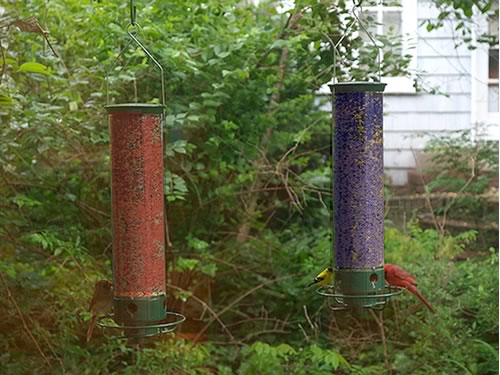Would you want to drink green milk, how about orange mashed potatoes? The color of foods might affect just how much you want to eat them, but what about the birds in your neighborhood, would they care what color their food is? This sounds like an experiment in the making…. you coul even try this out for a science fair project, or just to learn something new while making your locals birds happy.
You will need:
- Several bird feeders that are the same size and type
- Light colored birdseed appropriate for the birds in your neighborhood
- Several colors of food coloring
QUESTION – What color of birdseed, if any, will birds prefer the most?
RESEARCH: Ornithologists (scientists that study birds) are rather certain that most birds can see in color. One reason they think this is because birds themselves are very colorful. In many species, male birds tend to be more colorful than females. This is likely because the males use their coloring to attract a mate, while female birds tend to have less coloring to provide camouflage as they protect their eggs in the nest. Before beginning a large experiment with lots of bird seed, you may want to put out a few small handfuls of different colored birdseed (see instructions for coloring birdseed below) to see how the birds near you react to different colored seed. You may also want to refer to books and talk to an ornithologist to get their opinion about how birds see the word.
MAKE A HYPOTHESIS: Use the information that you’ve gained from your research and make a hypothesis based on your question. An example might be “Birds will eat more green birdseed than other colors.”
EXPERIMENT: This is the fun part. You should get several bird feeders that are all the same size and type. Purchase a bird seed that is very light in color for this experiment. To color the bird seed, pour it into a bowl and then add food coloring that you can purchase from the store. Mix it up well with a spoon and continue to add color until all the seed is colored. You should sample at least a few colors and have one feeder with seed that has not been colored – this is called the control and it will give you something to compare your results to. Now just hang them up outside in the same location, and wait for your feathered friends to show up. This works best in an area that birds are used to feeding from a feeder – it can take birds over a week to find new feeders.
COLLECT DATA: Observe your bird feeder whenever possible, and keep track of how much seed is in each bird feeder each day. A ruler is helpful for this. You might also want to take pictures of the feeders and keep track of which kind of birds visit each feeder. Over time, you should be able to see if one color of seed gets eaten more than others.
MAKE A CONCLUSION: Once your experiment is done, you will be able to go back to your hypothesis and see if it is correct. Remember,it’s not bad if your hypothesis was wrong. The main thing is that you’ve learned something from your experiment, and hopefully you had some fun doing it.
If you try this, let me know how it goes!
If you need inexpensive bird feeders, you can get some on-line HERE.
